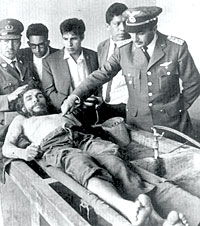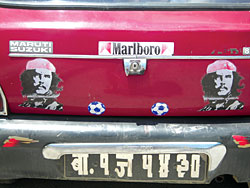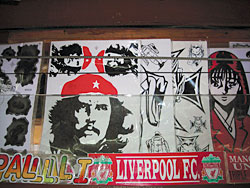 |
The New York Times responded editorially, and with evident satisfaction, that if the report proved true, "as now seems probable, then a myth as well as a man has been laid to rest." It was not the Times's most accurate prediction.
Photographs of Che's lifeless body soon appeared in newspapers around the globe, putting to rest doubts about his death. He had been executed. His amputated hands were smuggled to Cuba in 1970, and his bones were discovered by a Cuban forensic team in Bolivia in 1997 and returned to Cuba for state burial.
The mythic appeal of the slain revolutionary, known to many today in Latin America as San Ernesto, has only grown in subsequent years. In Che's Afterlife: The Legacy of an Image, Michael Casey writes, "Unwittingly, the Bolivian military delivered the world a lasting and sympathetic picture of the man they'd hunted down, they gave it a crucified Che." Indeed, John Berger and other art critics have argued that Freddy Alborta's photo of Che's corpse bears a startling resemblance to Renaissance depictions of Jesus Christ at the moment he was brought down from the cross by the Romans.
Che hardly ever sat for a bad photo, even in death. But of all surviving photographs of him, one in particular stands out: the head-and-shoulders portrait of a bearded, long-haired, 31-year-old Che, wearing a bomber jacket and his trademark beret emblazoned with the comandante star, taken by Alberto 'Korda' D?az Guti?rrez for Revoluc?on, the official newspaper of Fidel Castro's 26th of July Movement.
In the aftermath of Che's death, the Korda photo, or various graphic derivations, became a staple of radical newspapers and left-wing poster art in North and South America and Western Europe. And in an ironic post-1960s development, the image took on yet another life: this time as a marketing device, used to sell everything from air fresheners to condoms to an ice-cream bar called Cherry Guevara.
Che has since become a commodity. The issue is not that Che's image is without continuing political appeal but that it has too many diverse meanings to be the symbol of any coherent ideology. As one would expect, the Korda photo remains the symbol of choice for contemporary Latin American rebels.
 LISA SCHWoERER |
The contemporary meaning of Che's image ultimately isn't about communism or anti-imperialism: it's about attitude, and it's about sacrifice. Writes Casey: "A man, a teacher, lays down a code of personal conduct from which to build a just society, a utopia, and then proceeds to live and die according to it."
Castro combined the Cuban revolution, Che's stellar qualities, and the Guerrillero Heroico image into a single attractive product. Just as urban sneaker-wearing teenagers seem susceptible these days to advertisers who encourage them to identify with brands such as Nike or Tommy Hilfiger, in late 1967 radicalised students across the Western world were ripe for the Che brand.
And he continues to appeal to activists today. It is not only Guevara's high cheekbones, long eyelashes and cool bomber jacket that make this photo desirable. Its appeal also lies in its spirituality, in its ability to feed people's longings for a better world and to encourage them to dream of defeating death. Korda's Che keeps hope alive.
Maurice Isserman is James L Ferguson Professor of History at Hamilton College and the author, with Michael Kazin, of America Divided: The Civil War of the 1960s.
"Che who?"
 |
"A pure man of the proletariat, no capitalist-roader like our commies"
"Some cool dude with a funky hairdo"
"Che who?"
Yet stickers advertising the iconic silhouette of Che, he of the wispy beard, long hair and starred beret, can be seen on every other Kathmandu taxi, microbus and t-shirt. Che is a favourite among Nepali communists from Youth Communist League thugs to cabdrivers.
"The YCL is here from time to time," says Reetu Sahani of The Sticker Shop. One cabdriver pointed to a Che sticker on his rearview mirror to say this is the kind of leader Nepal needs.
Releases of the movie adaptation of Che's Motorcycle Diaries in 2004 and the more recent two-part Che biopic by Steven Soderbergh have boosted his popularity and sealed his communist credentials in the eyes of many Nepalis, but he's been popular for a longer time.
Many people buy Che stickers simply for his good looks and because they're fashionable. One store vendor in Kathmandu who sells Che memorabilia explains: "He doesn't have a special meaning for most people, they are just following a market trend."
In fact he's become such a commercial figure many owners of Che memorabilia don't know who he is. Others think they do but are usually way off the mark. A sample street survey in Thamel evoked a few more intriguing answers from young Nepalis: "This is Hitler"; "He was a European president"; and "He was a very smart man."
READ ALSO:
"The most complete human being of our age" - FROM ISSUE #466 (28 AUG 2009 - 03 SEPT 2009)


